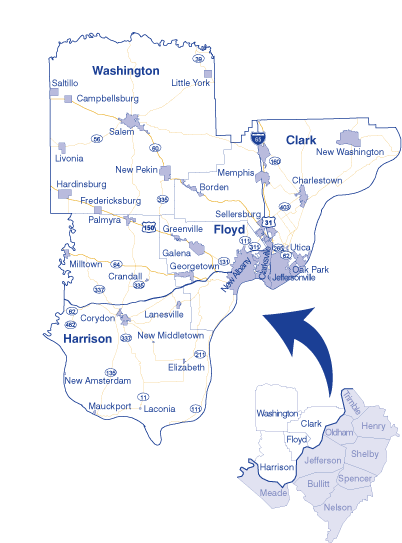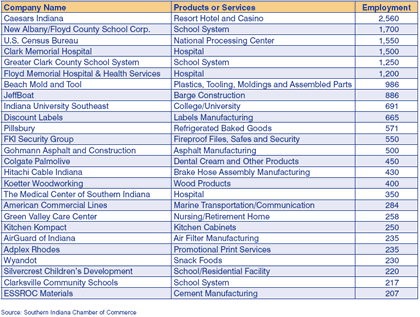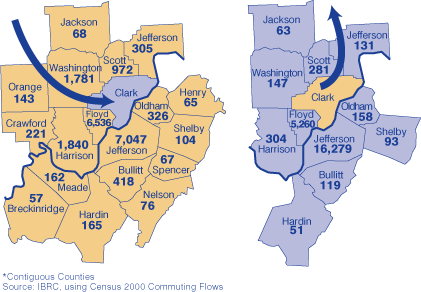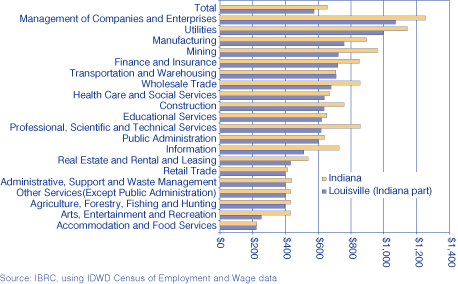The Hoosier Side of Louisville
The Area
The Louisville Metropolitan Statistical Area (metro) includes nine Kentucky counties and extends north of the Ohio River to encompass Clark, Floyd, Harrison and Washington counties in Indiana. These four Indiana counties contribute over 236,500 people (roughly 20 percent) to the metro’s total population, which exceeds 1.2 million. For purposes of this article, analysis will be focused on the Hoosier side of the Louisville region.

Indiana’s Clark County, home to Jeffersonville and Clarksville, is the second largest of the 13 counties in the metro with a 2004 population of 100,706. Floyd County follows with a population of 71,543. Half of that county’s population lives in New Albany, the largest city on the Indiana side of the metro.
Combined, the four Indiana counties have added about 7,000 residents since 2000. Looking at the percentage growth from 1990 and the growth from 2000, the Indiana counties have grown slower than many of their Kentucky counterparts (see Figure 1). The relatively low growth rates in the metro’s three largest counties (Jefferson, Clark and Floyd) are indicative of the strong suburbanization trends in less populated areas.
Figure 1: Louisville's 2004 Total Population and Growth
Population projections from the Indiana Business Research Center indicate that, by 2020, the four Indiana counties will grow 5.8 percent (nearly 13,800 people) from current levels. This is slower than the state’s anticipated growth of 8.1 percent. During this same time period, the number of senior citizens is expected to increase about 55 percent from Census 2000 levels; that is significantly faster than the state’s overall rate of almost 41 percent. Meanwhile, the region is anticipated to have noteworthy declines in the number of school-age children and young adults.
Major Industry News
Table 1 shows the region’s largest employers. Although the largest single employer in the region is Caesar’s Indiana, the four-county region mirrors the state’s industrial mix, with manufacturing (19.7 percent), retail trade (13.3 percent) and health care (12.1 percent) being the three biggest industries.
Table 1: Major Southern Indiana Employers
Manufacturing: Major manufacturers include Beach Mold and Tool, JeffBoat, Discount Labels, Pillsbury, FKI Security Group, Gohmann Asphalt and Construction, and Colgate Palmolive.
The June closing of the bankrupt Tower Automotive plant in Corydon and the resulting loss of 600 manufacturing jobs has been a recent shock to the local economy; it was Harrison County’s second-largest employer, and over half of its employees resided in the county.(1)
On the upside, Canadian-based Martinrea (fluid systems and metal-forming) purchased Corydon’s bankrupt Oxford Automotive plant earlier this year, keeping about 300 jobs in the county. In Clark County, MedVenture Technology Corp., a Louisville firm that designs and manufactures medical devices, announced it is relocating to Jeffersonville in the North Port Business Center (one of the state’s certified technology parks). About 70 percent of its 156 employees are Indiana residents, and MedVenture plans to expand to over 500 employees in the next five years. (2) Currently, the average hourly wage at the firm is near $24.
Retail Trade: Set to open just in time for the holiday season, the River Falls Mall in Clarksville will boast a new $30 million Bass Pro store, complete with its own restaurant, an indoor archery range, an outfitting shop for boats and a 60-foot-tall, 50,000-gallon aquarium. (3) The 280,000 square-foot mega-store will be the second-largest Bass Pro store in the nation (behind the flagship store in Springfield, MO). It is expected to be a boon to the tourism market in the area, as its seasonal seminars at other locations have drawn as many as 30,000 to 40,000 people, and it attracts an average of 2.8 million visitors annually.
Health Care: As seen from Table 1, two of the largest employers in the region are the county-owned hospitals in Clark and Floyd counties. A growing concern in the health care field is that private medical facilities will siphon the profitable procedures away from county hospitals, along with patients able to pay their bills, leaving the county hospitals to treat the indigent. In an effort to prevent this, Clark, Floyd and Harrison counties are three of four counties in the state to pass moratoriums on new health care facility construction (with Morgan County being the fourth). Currently, those moratoriums, except for the one in Harrison County, are being challenged in federal court. (4)
Commuting
Clark County has the largest commuting flows on the Hoosier side of the border, according to the Census 2000 figures. Eighteen counties had at least 50 people commuting into Clark County, drawing almost 8,500 workers from Kentucky. Meanwhile, over 16,000 Clark County residents worked in Jefferson County, the heart of the Louisville metro (see Figure 2).
Figure 2: Commuters to and from Clark County, 2000*
Wages and Compensation
Overall, the average weekly wage for the four-county region was $574 for the third quarter of 2004—about $80 less than the state rate. Compared to Indiana’s other metros, the average wages were higher than those found in the Indiana portion of Cincinnati-Middletown, Bloomington, Terre Haute and Michigan City–La Porte, but lower than the remaining 11 metros in the state.
At the industry level, all were below the statewide level, except for transportation and warehousing, where southern Indiana workers had a $1 advantage (see Figure 3). Three industries accounting for about 3 percent of the total workforce had average weekly wages that were more than $200 below the Indiana average for that industry: information, professional, scientific and technical services, and mining. Comparing these numbers to those from three years ago (2001:3), shows that all wages have increased, except those in professional, scientific and technical services, which declined by $28 (a 4.3 percent drop).
Figure 3: Weekly Wages and Compensation, 2004:3
When looking at the three industries employing the most workers (manufacturing, retail trade and health care), each saw significant average wage increases. In particular, manufacturing wages rose $122 (19.2 percent), and health care wages saw a $90 weekly increase (16.5 percent). Overall, management of companies and enterprises saw the largest increase in wages, both numerically ($290) and on a percentage basis (37.1 percent).
Notes
- Charles Ewry, “What the loss of 600 Tower Automotive jobs will mean for Corydon,” The Corydon Democrat 10 June 2005.
- Larry Thomas, “Jeffersonville woos MedVenture with $5.5 million bond issue,” The Evening News 21 June 2005.
- John L. Gilkey, “Bass Pro Shops set to open $30 million store Nov. 14 in Clarksville,” The Evening News 2 June 2005.
- Tom Murphy, “Debate over health care development takes legal twist” Indianapolis Business Journal 23 June 2005.
This article is part of an ongoing series covering
Indiana’s metropolitan statistical areas. Gain access to this and
the 10 previously published metros—Anderson through Lafayette—on
the newly redesigned InContext website.
As you will see from the schedule below, the four remaining metro areas
will all be available by the end of the year: |
By Rachel Justis, Managing Editor
Indiana Business Research Center, Kelley School of Business, Indiana University




